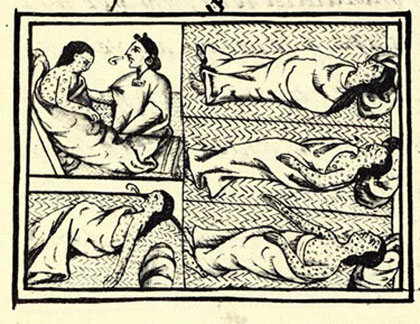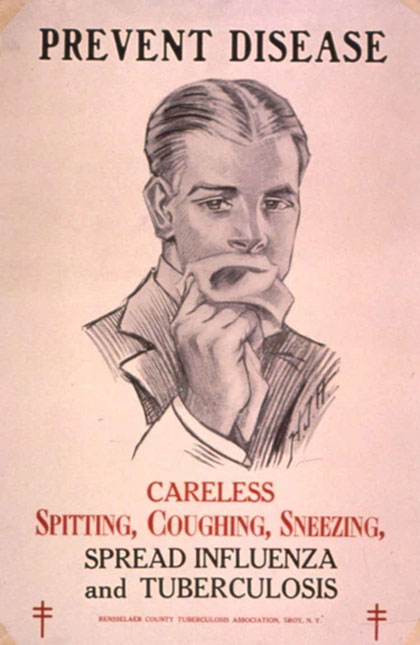
What Was The Most Significant Infectious Disease In Every Century?
Kellie Kreiss
When looking back through human history, one would be hard-pressed to find an era, civilization, or community that has not been impacted by an infectious disease outbreak. From the bubonic plague to influenza to cholera, epidemics and pandemics the world over have come in many shapes, sizes, and death tolls. But sometimes, the death toll alone doesn’t reflect the true, lasting impact that specific infectious disease outbreaks had on the populations they infected – or those nearby.
So, what was the most significant infectious disease from every century? And what impact did the diseases have on the populations, economies, and environments of the communities they forever altered? And what world was left for the survivors of these pandemics? The answers to these questions, in many centuries, live up to the reputations of their associated infectious diseases.
________________________________________
• Photo: Vinzenz von Beauvais / Wikimedia Commons / Public Domain
 1000s: Leprosy
1000s: Leprosy
While the origins of leprosy remain definitely unknown, the implications of the disease’s outbreak have left a large mark on human history.
After having suddenly gained its stronghold over communities in Medieval Europe in the early 1000s, leprosy remained a longstanding public health issue.
In an attempt to stifle the spread of the disease, leper colonies were created to quarantine symptomatic individuals. Unfortunately, without any treatment options, those inflicted with the disease were forced to suffer painful skin lesions which left them susceptible to other infection. Though leprosy is still prevalent today, it is largely treatable with antibiotics.
• Photo: Hieronymus Brunschwig/Science History Institute / Wikimedia Commons / Public Domain
 1100-1200s: Influenza
1100-1200s: Influenza
While large-scale disease outbreaks were relatively minor during the 1100s and 1200s, the diversity of the diseases present at this time all but made up for it. There was a consistent presence of well-known diseases such as measles, smallpox, and ergotism, but concerns surrounding these ailments were all but trumped by the prevalence of various influenza outbreaks.
These outbreaks continued throughout Europe for the better part of the Middle Ages, well into the 1400s. Interestingly enough, during this same time, many European cities were making great efforts to improve public health conditions and access to water for residents.
• Photo: Pierart dou Tielt / Wikimedia Commons / Public Domain
 1300s: The Black Death
1300s: The Black Death
With an estimated death toll between 75 and 200 million people, the Black Death swept across Europe in the mid-1300s and had a lasting and devastating impact on the landscape of the continent forever. Lasting only around four years in total, this outbreak of the plague – known as the “second of the Three Great Plagues” – first made its way into Italy in 1347 via sailors who had been working abroad in areas around China and India. The sailors, who arrived with black boils and spots on the skin, inspired the name of this devastating outbreak.
It’s believed that nearly half of the European population was killed as the disease spread so quickly that people would die in a matter of weeks, days, or even hours.
• 1400s: Syphilis
The latter half of the 1400s were marked by the steady, and then drastic, spread of the infectious sexually transmitted disease syphilis. What was then often referred to as the “Disease of Naples” or “French Disease,” syphilis made its first large-scale appearance among the soldiers in King Charles VIII of France’s army as they attempted to gain control of Naples in 1494.
It was shortly after the army gained control of their targeted territory that symptoms of syphilis began to spread, and infection became prevalent. From here, as soldiers returned home, syphilis joined them and continued to spread across more European communities. Then, with the help of the invention of the printing press and the new-found ability to transmit medical information more easily to the masses, syphilis became known as a primary public health crisis in communities across Europe. And because of its uncertain origin, people began associating it with peoples and countries they either believed in came from or for which they had existing prejudices.
• Photo: Bernardino de Sahag / Wikimedia Commons / Public Domain
 1500s: The Columbian Exchange
1500s: The Columbian Exchange
The Columbian Exchange marks a particularly complicated time in human history, the impact of which is still unmistakably felt today.
During this time, different factions of humanity that had been long separated by land and sea were once again reunited. The term Columbian Exchange, which was coined by historian Alfred Crosby, refers specifically to the sudden globalized commingling of not only people and technology but of animals, plants, and diseases.
As European colonizers and traders expanded their reach into the Americas, Africa, and Asia with the help of faster ships and stronger weapons, they brought a whole slew of diseases with them, their livestock, and plants which quickly ravaged the local populations they met with due in large part to the fact that they had no immunities built up to those particular diseases. Some of the most devastating among them included smallpox, measles, influenza, and typhoid. This deadly combination of diseases wiped out numerous civilizations and took millions of lives.
• Photo: Robert Valette / Wikimedia Commons / CC BY-SA 4.0
 1600s: Bubonic Plague
1600s: Bubonic Plague
As one of the better-known infectious diseases from human history, the bubonic plague has made a name for itself both in its scale and its devastation. The most historically significant of the many plague outbreaks may be attributed to the epidemic that hit London and, to a lesser extent Europe as a whole, during the mid-1660s.
Known as the Great Plague of London, this iteration of the bubonic plague broke out in London in 1665 and spread so quickly that nearly 20% of the city’s inhabitants perished. That resulted in a city infrastructure unable to process bodies fast enough to contain the disease, resulting in mass graves around the city. By 1666, the plague’s progress had finally slowed.
• 1700s: Influenza
Before the 1700s, there had yet to be an epidemic outbreak at a scale large enough and far-reaching enough to qualify as a pandemic. That changed, though, in 1729 with the rapid spread of an influenza outbreak. Having originated in Russia, the influenza infection reached pandemic proportions within six months time as it infected populations across Europe and the United States before being brought under control a year later in 1730.
This outbreak was followed a few decades later, in 1781, with another influenza outbreak of a much larger scale, which is believed to have originated in China before spreading across and resulted in tens of millions of infections throughout Europe, with a particularly high mortality rate among young people.
• Photo: National Library of Wales / Wikimedia Commons / Public Domain
 1800s: Cholera
1800s: Cholera
Cholera’s designation as a pandemic is complex, for each individual outbreak may at first appear small in scale, but when looked at as a larger collection of outbreaks, the numbers become staggering. The disease became a particular concern during the 1800s, with at least five large-scale outbreaks leading to the loss of nearly one million lives. The first known outbreak, which occurred between 1817 and 1823, began in India’s Ganges River area, quickly spreading across the country until it eventually achieved widespread infection with the help of trade and colonization in neighboring regions including Southeast Asia, the Middle East, Africa, and Europe. Later outbreaks erupted throughout the 19th century.
The 1852-1859 pandemic, which has been recorded as the deadliest of the century, also led to a particularly impactful epidemiological public health discovery thanks to the work of a British physician named John Snow. This outbreak led to a significantly high number of deaths in London and – in an effort to combat its spread – Snow worked to trace the origins, operating off of a hunch that the city’s water supply had something to do with its spread. After mapping out the spread of the disease and comparing it to the water pumping systems in the city, Snow was able to identify the exact water pump responsible for the disease’s transmission, and with its removal, the disease all but disappeared.
• Photo: Otis Historical Archives, National Museum of Health and Medicine / Wikimedia Commons / CC BY 2.0
 1900s: Spanish Flu
1900s: Spanish Flu
In what is estimated to be the worst pandemic in human history, the Spanish Flu, which ravaged the European and American continents from 1918 to 1920, took the lives of between 20 and 50 million people within a span of two years – which is between two and four times more people than were killed during the entirety of WWI. Believed to have originated in China as a type of avian flu, it quickly spread as a result of workers and laborers being transported across the continents. Despite its sudden and vast stronghold on the global population, the disease quickly dissipated by the end of 1919 due to a high death toll and developed immunities.
In addition to the Spanish Flu, the 1900s also saw the rise of the HIV/AIDS epidemic which remains smaller in scale with an estimated 35 million deaths worldwide,but has had a significant social, cultural, and health impact on the modern world. HIV/AIDS infects people by attacking the immune system and making the body more susceptible to other diseases that would otherwise be curable. To date, there are a number of treatments available, but there is still no reliable cure for the disease.
• Photo: U.S. National Library of Medicine / Wikimedia Commons / Public Domain
 2000s: Tuberculosis
2000s: Tuberculosis
Despite the fact that it is both curable and preventable, tuberculosis remains one of the World Health Organization’s (WHO) top 10 most deadly infectious diseases. Due in part to its easy air-born transmission and somewhat subtle initial symptoms, people can go undiagnosed for long periods of time while inadvertently infecting others around them. In 2018 alone, there were an estimated 10 million new diagnoses and 1.5 million deaths worldwide from tuberculosis, the majority of which struck individuals in developing countries. Additionally, there is a growing prevalence of a multi-drug resistant strain of tuberculosis, which has led WHO to double-down on their prevention efforts, instating an official “End TB Strategy.”
Other infectious disease outbreaks prevalent during this time include Ebola, SARS, and Coronavirus, though on a global scale none of these has had as great an impact on the state of global health as tuberculosis. The significant social and cultural impact of the internet age and social media has led to an increase in attention to these and other infectious disease outbreaks worldwide, despite their lesser long-term overall reach.
ranker.com























